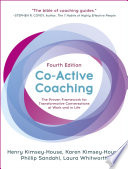Co-Active Coaching:
Co-Active Coaching by Henry Kimsey-House, Karen Kimsey-House, and Phillip Sandahl is a foundational text in the professional coaching world. Now in its fourth edition, the book provides a comprehensive guide to the Co-Active model of coaching—a transformative, client-centered, and holistic framework that empowers individuals and teams to achieve their highest potential. This summary offers a deep dive into the core concepts, frameworks, and tools of Co-Active Coaching while transforming them into digestible insights relevant for both aspiring and experienced coaches.
The Essence of Co-Active Coaching
At its core, Co-Active Coaching is about creating a partnership between coach and client that is grounded in respect, curiosity, and trust. The term “Co-Active” reflects the active collaboration between coach and client, where both bring valuable energy and insight to the process. It is built upon the belief that people are naturally creative, resourceful, and whole.
The Four Cornerstones
The Co-Active Model is structured around four philosophical cornerstones:
- People are Naturally Creative, Resourceful, and Whole: The coach does not fix the client. Instead, they trust in the client’s own capacity for insight, choice, and transformation.
- Coaching Addresses the Client’s Whole Life: Clients are more than the sum of their professional goals. Effective coaching engages the whole person—career, relationships, health, purpose, and spirituality.
- The Agenda Comes from the Client: The client owns their journey. Coaches serve as facilitators, not directors.
- Coaching Is a Designed Alliance: Coach and client co-create the relationship through intentional conversations and agreements.
The Co-Active Coaching Model
The model includes five key contexts that shape coaching engagements:
-
Listening: Coaches cultivate deep, intuitive listening. The book outlines three levels:
- Level 1: Internal listening (focus on oneself).
- Level 2: Focused listening (tuned into the client).
- Level 3: Global listening (sensing mood, energy, and environment).
-
Curiosity: A coach’s superpower. Open-ended questions and genuine interest help clients explore hidden beliefs and opportunities.
-
Intuition: Coaches are encouraged to share intuitive insights—not as truth, but as possibilities for reflection.
-
Self-Management: Coaches monitor their own reactions and assumptions to stay present and serve the client.
-
Coaching Presence: This is the art of being fully available and engaged with the client. It’s not a technique—it’s a way of being.
The Five Contextual Dimensions of Co-Active Coaching
The authors define five dimensions that shape coaching conversations:
1. Fulfillment
Fulfillment is about helping clients live in alignment with their values and purpose. This dimension involves identifying core values, dreams, and passions, and finding meaningful ways to express them.
- Tools and Practices:
- Life purpose exercises
- Values clarification
- Visualization of a fulfilled life
2. Balance
Balance is about creating perspective and helping clients make empowered choices. Rather than feeling stuck, clients learn to examine alternatives and shift their vantage point.
- Tools and Practices:
- Exploring perspectives (e.g., “What would your future self say?”)
- Saboteur identification
- Designing sustainable action plans
3. Process
Process coaching helps clients navigate emotions, transitions, and uncertainty. It involves being present with what’s happening in the moment—joy, grief, confusion, excitement—and trusting that allowing emotional experience leads to growth.
- Tools and Practices:
- Naming emotions
- Somatic awareness
- Pausing and holding space
4. Relationship
The coaching relationship is the container for all other dimensions. Coaches are not passive observers—they are part of a co-created alliance that requires authenticity and vulnerability.
- Coaches actively build trust, provide feedback, and sometimes challenge clients, always within the designed alliance.
5. Structures
Structures ensure follow-through and accountability. They are the practical side of coaching—reminders, routines, and agreements that turn insight into action.
- Tools and Practices:
- Weekly action plans
- Accountability structures
- Check-ins and progress tracking
The Coach’s Toolkit
The book provides concrete tools and language that coaches can apply immediately:
- Powerful Questions: Open-ended, evocative questions like “What does success feel like for you?” or “What’s the deeper truth here?”
- Acknowledgment vs. Validation: Acknowledgment celebrates who the client is, not just what they do.
- Forward and Deepen: Each coaching conversation should move forward (action) and deepen (awareness).
- Designing the Alliance: Every session begins with mutual clarity about outcomes and roles.
- Completion: Sessions are wrapped up with reflections and commitments.
Common Pitfalls and Growth Edges
Co-Active Coaching also explores the common missteps new coaches face:
- Fixing vs. Empowering: Coaches must resist the urge to solve problems. Their role is to evoke the client’s own solutions.
- Over-reliance on Tools: While structures are helpful, presence and connection are paramount.
- Underestimating Silence: Silence is not emptiness. It’s often the gateway to insight.
Beyond Individual Coaching: Leadership and Teams
Later chapters expand Co-Active Coaching to team and organizational contexts. The principles remain consistent, but the application involves group dynamics, collective visioning, and shared accountability.
- Coaches learn to work with team values, roles, and culture.
- Facilitative leadership replaces directive management.
Ethical Grounding
The book emphasizes ethical boundaries, confidentiality, and the importance of continued supervision and learning. Coaches are urged to operate with humility and a commitment to their own growth.
Why Co-Active Coaching Matters
In a world that values speed, productivity, and outcomes, Co-Active Coaching offers a radically human alternative. It teaches that transformation happens not by fixing people, but by deeply honoring their wholeness. It elevates coaching from a technique to a partnership, where presence and curiosity open the door to profound change.
Final Reflections
This model is not static—it evolves with the coach and client. Its versatility allows it to work in executive coaching, life coaching, career transitions, and even personal relationships. For any coach committed to ethical, transformative, and human-centered practice, Co-Active Coaching is an indispensable guide.
Note: This summary is a transformative and original interpretation of Co-Active Coaching and is intended for educational and informational purposes only.

